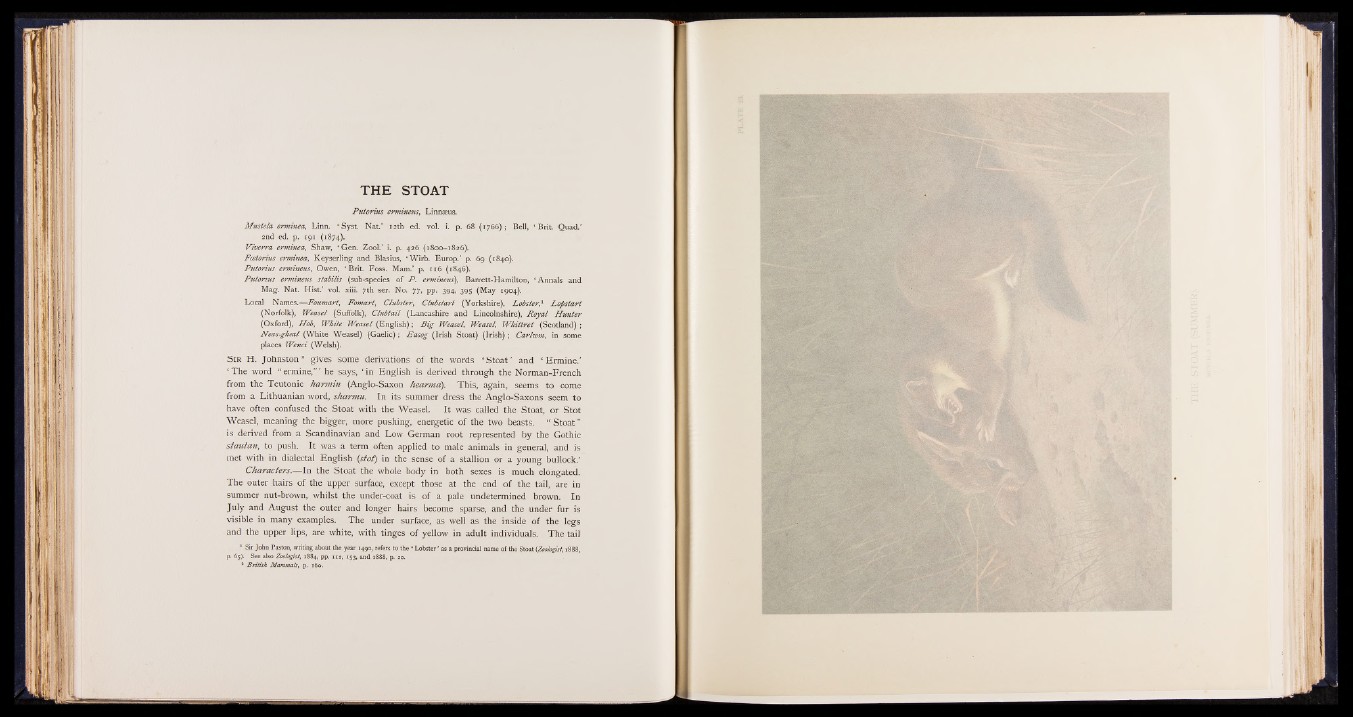
THE STOAT
Putorius ermineus, Linnaeus.
Mustela erminea, Linn. ‘ Syst. Nat’ 12th ed. vol. i. p. 68 (1766); Bell, ‘ Brit. Quad.’
2nd ed. ^ 191 (1874).
Viverra erminea, Shaw, ‘ Gen. Zool.’ i. p. 426 (1800-1826).
Fcetorius erminea, Keyserling and Blasius, ‘Wirb. Europ.’ p. 69 (1840).
Putorius ermineus, Owen, ‘ Brit. Foss. Mam.’ p. 116 (1846).
Putorms ermineus stabilis (sub-species of P. ermineus), Barrett-Hamilton, ‘ Annals and
Mag. Nat. Hist.’ vol. xiii. 7th ser. No. 77, pp. 394, 395 (May 1904).
Local Names.—Foumart, Fomart, Clubster, Clubstart (Yorkshire), Lobster} Lopstart
(Norfolk), Weasel (Suffolk), Clubtail (Lancashire and Lincolnshire), Royal Hunter
(Oxford), Hob, White Weasel (English); B ig Weasel, Weasel, W hittret (Scotland) ;
Neas-gheal (White Weasel) (Gaelic); Easog (Irish Stoat) (Irish); Carlwm, in some
places Wenci (Welsh).
S ir H. Johnston3 gives some derivations of the words ‘ Stoa t’ and ‘ Ermine.’
‘ The word “ ermine,” ’ he says, ‘ in English is derived through the Norman-French
from the Teutonic harmin (Anglo-Saxon hearma). This,- again, seems to come
from a Lithuanian word, sharntu. In its summer dress the Anglo-Saxons seem to
have often confused the Stoat with the Weasel. It was called the Stoat, or Stot
Weasel, meaning the bigger, more pushing, energetic of the two beasts. “ Stoat”
is derived from a Scandinavian and Low German root represented by the Gothic
stautan, to push. It was a term often applied to male animals in general, and is
met with in dialectal English (slot) in the sense of a stallion or a young bullock.’
Characters.—In the Stoat the whole body in both sexes is much elongated.
The outer hairs of the upper surface, except those at the end of the tail, are in
summer nut-brown, whilst the under-coat is of a pale undetermined brown. In
July and August the outer and longer hairs become sparse, and the under fur is
visible in many examples. The under surface, as well as the inside of the legs
and the upper lips, are white, with tinges of yellow in adult individuals. The tail
1 Sir John Paston, writing about the year 1490, refers to the ‘ Lobster ’ as a provincial name of the Stoat (Zoologist, 1888,
p. 65). See also Zoologist, 1884, pp. 112, 153, and 1888, p. 20.
2 British Mammals, p. 160.